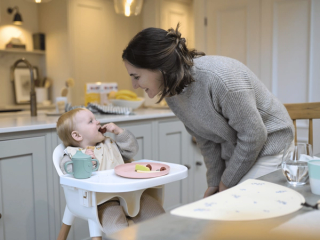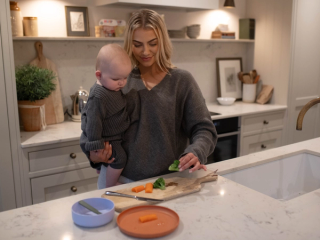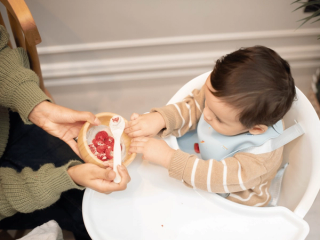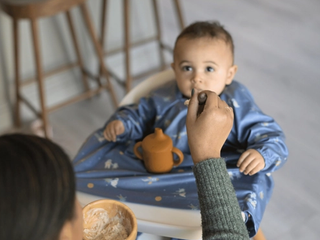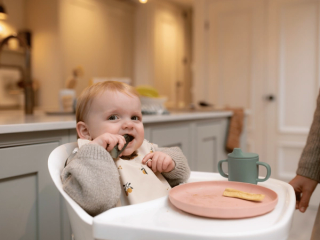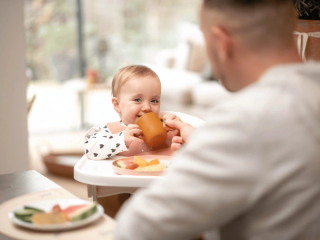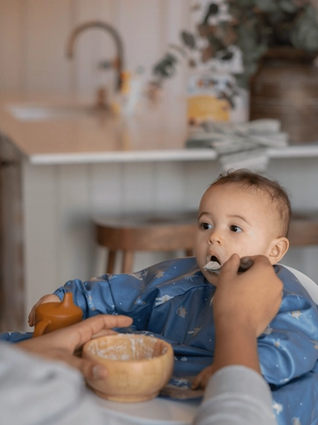
- Home
- Advice Hub
- Baby
- Weaning
- How To Get Started With Weaning
How to get started with weaning
Our Paediatric Dietician Lucy Wood shares her advice from what to expect, starting with green vegetables and when to give solid foods.
Before you get started, there are a few things to go through which we hope will help you feel confident and more prepared as your baby transitions to solid foods.
What to expect
When babies are born, they have a suck reflex for feeding, which is needed for easy access to milk from a breast or a bottle teat. When solid food is introduced, they need to learn how to keep their tongue in their mouth and how to move food around in such a way that makes it easy to swallow.
At first, you may find that food just gets pushed out of the mouth by the tongue pushing forward as if your baby is milk feeding. Try to be patient and allow for time to learn. Sitting and eating with your baby so that they can watch you is a great way for them to learn and there are lots of other benefits to sitting together too! Research worldwide shows1 that the simple act of a family mealtime can improve fruit and vegetable intake, improve connection between family members, reduce depression, and even improve academic achievement during school years.
Try not to compare your baby with others; all babies eat different amounts. Providing your baby seems happy after meals and is growing well you don’t need to worry about how much they are eating. We talk more about volumes of food in our article HERE.
Wean with green
It is recommended that at the start of weaning you spend a week or two giving green vegetables. This is because research shows that babies who are given bitter tastes before sweet may eat vegetables better during toddlerhood. Knowing how difficult it can be to get a toddler to eat vegetables, we think this is a step worth taking!
Breast milk and formula1 are both sweet and babies are born with well-developed sweet taste buds. If we start the weaning journey with sweet flavours, this can just reinforce your baby’s preference and result in a much sweeter tooth. Unfortunately, we don’t have much in the way of green vegetables in our range but you can puree your own at home or offer them as finger foods. Any green vegetables will work – courgettes, spinach, broccoli etc. White potatoes and aubergine also count as bitter vegetables so you can use these too.
To puree your own green vegetables, you can steam a portion until cooked through then blend using whichever blender you are using at home. Add a little breastmilk, formula or cooled boiled water to get to a thick yoghurt consistency. If your baby is 6 months, you can serve these as finger foods too. Cut the vegetables into chip shape chunks about the size of your index finger and allow your baby to pick it up in their fist and eat it. To find out more detail about the safety of finger foods and how to offer them you can read the article HERE.
When to give solid food
When your baby first starts eating solid foods, they don’t always understand that food satisfies their hunger. This is sensory input that they need to learn.
That means that, if you try to offer solid food to a baby who doesn’t know it will fill them up, they may get upset and keep crying for milk. If you continue offering solids when your baby is really hungry, you may run into problems such as a baby not wanting to get in the high chair or crying when they see the bib or bowl coming out.
Instead, try to feed your baby when they are about halfway between milk feeds . This means they’ll be hungry enough to be interested, but not so hungry that they’re screaming out for a milk feed. For example, if your baby is having milk every 4 hours, offer them food around 2 hours after their milk feed. This may mean that at first you’re offering food at times that don’t necessarily fit with what you’d usually do, but don’t worry too much about that.
Over time this will become less of an issue as your baby will quickly start to learn the feeling of fullness when they eat, and you will be able to feed more to a regular routine that fits your timings!
How many meals to start with?
You only need to give one meal a day to start with, and this is likely to only be a few mouthfuls. You really don’t need to be concerned with how much your baby is eating; it’s more important to get the environment right and to offer variety than volume. Most of your baby’s nutrition is coming from milk at the moment.
There’s no right or wrong with which meal you start with, but many parents find it easy to start with breakfast as psychologically we often feel good about doing things when we first get up. That definitely isn’t for everyone though, so if you’d rather start with a different meal that is up to you.
A couple of things to consider:
- Getting out of the house: Do you like to be out during the daytime? If so, starting with breakfast might be a good idea. You can feed your baby and then head out without the worry of needing to feed them and clean them up after, which can feel stressful for many parents when they first get started. Plus you’ll avoid needing to think about heating food, refrigerating leftovers or storing dirty spoons in your bag.
- Allergies: It’s unlikely your baby will have a food allergy as only around 5-7% of babies in the UK are affected. At the start of weaning, we would recommend introducing allergens for the first time early in the day. That way, if there is a problem and you need to get advice, the process will feel more manageable than it would late in the evening or at night time.
Increasing to three meals a day looks different for each baby. You don’t need to rush; it is far better to take your time and really adjust. You can read more about building to three meals in our article HERE.
Advice & tips

Want to read more? Join the HiPP BabyClub for full access to this article.
As a BabyClub member, you'll get access to a range of exclusive benefits, including:
Monthly competitions
Discounts from our Partners
Expert advice tailored to your little one's age
Weaning recipes
HiPP shop discounts*
*10% off HiPP's online shop does not apply to our First Infant, Anti-Reflux or Comfort Formula Milk.
Important notice: Breastfeeding is best. Follow on milk should only be used as part of a mixed diet from 6 months. Talk to a healthcare professional.




